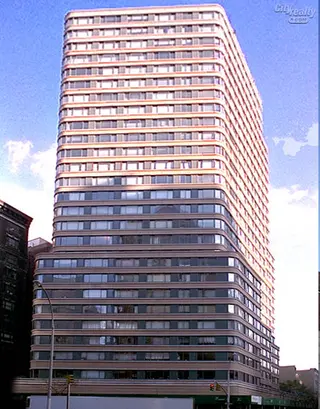 Carter Horsley
Carter HorsleyDec 23, 2011
Carter's Review
The 28-story, Copley residential condominium tower at 2000 Broadway on the northeast corner at 68th Street is relatively modest by the standards of "luxury" residential high-rise construction of the past two decades, especially in the neighboring Lincoln Center district.
Completed in 1987, this 162-unit tower is nicely detailed and was designed by Davis, Brody & Associates, one of the city's premier residential designers better known for their more sharply angled forms.
Bottom Line
A building with sensuous and cascading curves, this tower has a very central and fine Upper West Side location close to many restaurants, the Lincoln Center for the Performing Arts, good public transportation and Central Park.
Description
In their great book, “New York 2000, Architecture and Humanism Between The Bicentennial and The Millennium,” Robert A. M. Stern, David Fishman and Jacob Tilove wrote that the Copley was “the least banal” of three new towers completed “in quick succession in the late 1980s. Noting that it replaced the Colonial Bank designed in 1907 by Hoppin & Koen, the authors said that “eschewing a contextual approach in favor of piling up horizontal bands of windows alternating with tan brick spandrels, the design, with its round corners, impressed the editors of the AIA Guide, who deemed it ‘a sleek, smooth, modest, understated, rounded tower among the mess of Broadway.’”
The authors also noted that Paul Goldberger, then architecture critic of The New York Times observed that it was “the best new building on Broadway.” The authors, however, quickly added that “such praise for so mediocre a building suggested the low standards of the late 1980s, presented by John Harding & Associates’ red brick Bel Canto (1987), 1991 Broadway between Sixty-seventh and Sixty-eighth Streets, a twenty-seven –story, seventy-five unit, narrow midblock building with chamber-cut balconies for each apartment, and by Eli Attia’s 120-unit, charcoal-gray-brick Chequers (1989) at Sixty-second street, southwest corner of Broadway, which was only a bit better, a twenty-five story tower rising in a sawtooth patter behind a seven-story base angled to hold the line of Broadway.”
The building is not “mediocre” and its large rounded corners, a rarity still in New York, are quite welcome.
Although this tower's broad façade is along Broadway, its "showcase" façade, not surprisingly, faces south towards midtown. This façade is rather complex and reminiscent of some designs by architect Helmut Jahn, who is based in Chicago. The façade that face east, interestingly, has a projecting center portion that conjures a full waterfall.
The rounded corners turn into a projecting, non-curved, vertical element that provides more corner windows. The center bay of this façade, which is stepped, is a bit like a necktie cascading down between rounded shoulders. The complex composition of this façade is also a bit like a smoothed superstructure on an oceanliner, only without a rakish prow. While such a metaphor is a bit stretched here, there is a subtle and effective dynamic in play.
One might well ask, however, what do curves have to do with the traditional cornice lines and building profiles of older Broadway? Not much, except that one of the boulevard's great dames is the Ansonia, a few blocks to the north with its rounded turrets, so issues of context are rather moot.
Amenities
The building has a garage, a health club and pool, a children's playroom, storage, a doorman and is pet-friendly.
Apartments
Apartment 3A has a 7-foot-long foyer next to the 9-foot-long pass-through kitchen and a 27-foot-long living/dining room.
Apartment 11G is a one-bedroom unit that has a 7-foot-wide foyer next to a 7-foot-long kitchen that opens to a 25-foot-long, angled and curved living room.
Apartment 10A is a one-bedroom unit with a 22-foot-long living room with two curved corners.
Apartment 10K is a two-bedroom unit with a 10-foot-long foyer that leads to a 20-foot-long living room with a curved window wall and a 64-foot-long terrace that wraps around the corner apartment.
Penthouse 2A is a three-bedroom unit that has an entry foyer across from an enclosed 11-foot-long kitchen and a 17-foot-square living room with a rounded window wall and an atrium dining that is 16 feet long. The master bedroom has a curved window wall.
Penthouse 3 has a 26-foot-wide private landing that leads to a 53-foot-long gallery that ends tin a 35-foot-wide living/dining room and a 20-foot-wide solarium next to a 20-foot-wide eat-in, open kitchen with an island. The five-bedroom apartment has a 75-foot-long terrace.
History
An article by Katherine Clarke in the July 25, 2012 edition of therealdeal.com said that “a 4,800-square-foot Lincoln Square penthouse on the market for $16 million is slated to hit the foreclosure auction block next month with an outstanding lien of $22.1 million. The apartment is on the building’s 28th floor and the dispute is between Investec Bank, the mortgage lender based in the United Kingdom, and Opalgem Investments, a corporation based in the British Virgin Islands that owns the apartment."
The article said that “a subsidiary of Opalgem, a limited liability company named Elite International Finance, purchased the Copley apartment for $9.06 million in 2004 and took out a $15 million mortgage from Investec against the property four years later….According to the final judgment against the property, dated June 26, the defendant has not responded to filing.”

- Condo built in 1986
- 1 apartment currently for sale ($2.375M)
- 1 apartment currently for rent ($0)
- Located in Lincoln Center
- 163 total apartments 163 total apartments
- 10 recent sales ($872K to $1.6M)
- Doorman
- Pets Allowed
 6sqft delivers the latest on real estate, architecture, and design, straight from New York City.
6sqft delivers the latest on real estate, architecture, and design, straight from New York City.
